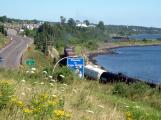36
CRANES - The Point Tupper rail yard said good bye to steam in 1954 when its last steam driven crane was retired. The crane pictured is set up for driving steel pilings. This and similar cranes could be dispatched by rail to points along the line that needed maintenance or where a derailment had occurred. One locomotive, Number 79, derailed more than once on the Point Tupper to Inverness rail line.In the background, the pilot house of the Scotia II rail ferry can be seen. Except in cases where locomotives needed to be brought to and from Cape Breton Island, it was only rail cars that were transported on the ferries. The railways on the island had their own locomotives and would receive the cars and transport them. The Inverness Railway and Coal Company operated only on Cape Breton Island and the Canadian National line to Sydney was serviced by a number of locomotives dedicated to that line.
39
RAILROADING IN THE STRAIT OF CANSO WOULD SURVIVE AFTER THE CANSO CAUSEWAY OPENED FOR RAIL TRAFFIC ON MAY 14TH,1955, BUT IT WOULD NEVER BE THE SAME AGAIN41
FREIGHT BOATS FOR NEWFOUNDLAND -The community of Mulgrave continued having freight trains such as these in 1979 coming to their wharf where the Newfoundland freight boats docked.43
In 1985, after one previous attempt to abandon the rail line from Port Hastings to Inverness, Canadian National Railway was granted permission to abandon the line. The line, which saw its last passenger train in 1959, had fallen into near disuse in its final years, with only one freight train per week traveling up the western coast of Cape Breton. During the final years there were only two crews maintaining the line, and the disrepair of the track was evident in the speed regulations on the line - trains could not exceed 15 miles per hour.With approval to abandon the line, crews began to remove the rails and ties. In this 1987 picture, taken in Creignish, about 10 kilometres north of Port Hastings, rail is pulled by work crews, ending the almost 90 year history of rail service to Western Cape Breton.
45
LAST CNR FREIGHT TRAIN - The last Canadian National Railway freight train to leave Cape Breton Island was made up of 5 diesel engines, 35 cars and 1 caboose . The driver was Conrad Clark, the conductor was E.W. Ross and the brakeman, Kevin Musgrave.46
Cape Breton and Central Nova Scotia Railway on the Canso Causeway2000
Railway Line Strait of Canso

47
A NEW TRAIN ROLLS INTO THE STRAIT AREA -On October 1,1993, the American rail company, Railtex, bought the remaining railroad from Canadian National Railway. That included the Sydney to Point Tupper and Port Hastings line along with the line from the Canso Causeway to Truro. They formed the Cape Breton and Central Nova Scotia Railway. With the purchase, CB & CNS also took control of the swing bridge over the Canso Canal on the Canso Causeway.Their cars are seen at the Martin Marietta quarry at Cape Porcupine being loaded with coal that has just been unloaded from a bulk carrier .
48
Cape Breton and Central Nova Scotia Railway train crossing Canso Causeway and Canal2000
Canso Causeway

49
Cape Breton and Central Nova Scotia Railway2004
Port Hastings, Inverness County, Nova Scotia, Canada





